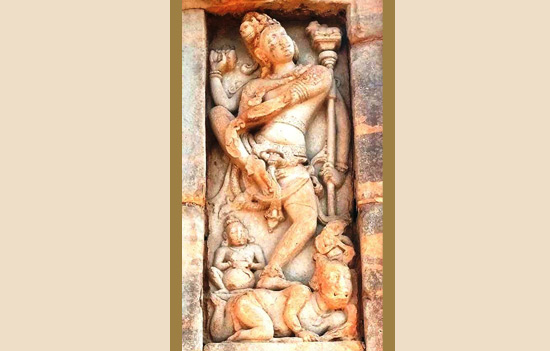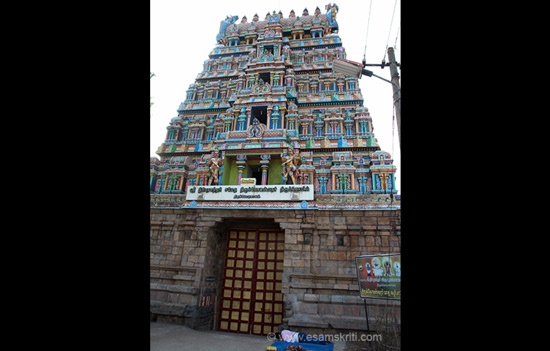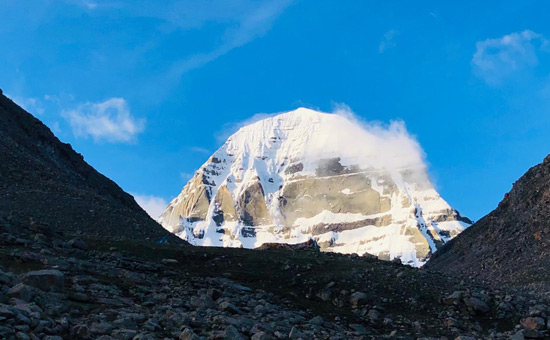- Adheenams are part of ceremony to inaugurate new Parliament. Know about Sengol tradition and who are Shaiva Adheenams? What is Siddhanta Shaiva and names of Adheenams of Tamil Nadu.
The Adheenams of Tamil Nadu have come into the limelight because it is they who will hand over the Sengol to Prime Minister Modi for being placed next to the speaker’s podium at the yet to be inaugurated new Parliament House. The questions being asked, what is Sengol tradition? Who are Adheenams?
About Sengol tradition
The coronation ceremony of a king was considered to be a
very auspicious moment in the history of the nation. To mark the event, the
king was endowed with three royal insignas-the crown (mukuta), the royal sword (khadga)
and the sceptre (rajadanda). While
the crown signified the King to be the sole leader of the nation, the sword was
the deterrent force which kept the opponents at bay and the sceptre denoted the
rule of just law where the virtuous citizen was offered protection and the vile
punishment. These three symbols were passed over generations to press the
greatness of the lineage.
Rajadanda or the Sengol is thus a pan-Indian phenomenon which can be
seen in the coins of Samudragupta, and referenced in many literary works and
travel accounts. When the kings were traditionally Shaivites, the danda had the
symbol of Vrsha (sacred bull), while the
Vaishnavites adorned the sceptre with Garuda, both signifying Veda and Dharma.
 Rishabha Danda, Virupaksha Temple, Pattadakal, Karnataka. The one who is being stamped is demon Apasmara. The others are Shivaganas who are giving rhythm to the Natesha's dance.
Rishabha Danda, Virupaksha Temple, Pattadakal, Karnataka. The one who is being stamped is demon Apasmara. The others are Shivaganas who are giving rhythm to the Natesha's dance.
Picture by Muthu Guide, Pattadakal. Wish to thank him for
sending pic in 10 minutes of my call. Contact number 91 94494 38078 - Editor.
See album
of Pattadakal
Temples, a UNESCO World Heritage site
To mark their role in the administration of the
land, when the power was transferred from the British to the first Prime
Minister of India, it was the tambiran representing the Tiruvavatuturai Adheenam who passed on the holt
staff of Dharma (Sengol: semmai kol-The staff that denotes just rule) accompanied by the recitation of the sacred hymn of the Shaiva child-saint Tiru-Jnanasambandhar, “Kolaru Tiruppadigam”. The Hymn ends with “arasalvar aanai namade”, meaning “they will rule; this is our command.”
Tiru-Jnanasambandhar promises Divine Sovereignty
and Rulership to those who recite His Divine Hymn. This is the promise of our
Divine Sambandhar, one who was fed milk by Devi Herself, one who was accepted
as a son by the three-eyed Mahadeva Himself.
This promise is the reason why we need not lose
hope for Bharata.
Read Sengol is symbol of Dharma over Power And Decoding Sengol-Dharma Dand And Significance of Sengol
Who are Shaiva Adheenams?
For the followers of the Agamic traditions
(Shaiva as well as the Vaishnava), the aims of the religious practice (sadhana) embraced not just the release (mukti), but also personal gain and
general prosperity (bhukti).
The option of bhukti and the path to liberation make no contradiction as the philosophical traditions they followed admitted and affirmed the physical world. This acceptance of the physical world acknowledged it as an arena of operation for both the deity's powers and for those who aspired to supreme states of knowledge.
The Saivagamas are classified as Monoist (Bhairavagamas) and Pluralists (Siddhantagamas).
Saint Tirumular, like his satguru, Nandinatha, propounded monism in which Shiva is both the
material and efficient cause, immanent and transcendent. His Tirumandiram
unfolds the way of Siddhanta as a progressive, fourfold path of jnana- wisdom of unitary consciousness, charya-virtuous and
moral living, kriya- temple worship, and yoga—internalized worship and union with Para Shiva through the grace of the living satguru—which leads to the state of jnana and liberation.
Thus, the importance of having a preceptor or
Guru is one of the fundamentals requirements for liberation in the Agamic
traditions.
The entire gamut of Kashmir Shaivism falls under the monoist
school (Paramadvaita) of Shaivagamas.
Siddhanta Shaiva
Aghorasivacharya, the head of the Åmardaka Matha in Chidambaram inaugurated a new Siddhanta, divergent from the monistic Shaiva Siddhanta. To this day, Aghorasiva’s Siddhanta philosophy is followed by almost all of the hereditary Sivacharya (Shaiva temple priests), and his paddhati texts on the Ågamas have become the standard puja manuals.
In the thirteenth century, Meykandar laid the
foundation of the Meykandar Sampradaya
through his composition Sivajnanabodham,
which propounds a pluralistic realism wherein God, souls and world are
coexistent and without a beginning. Shiva is efficient but not material cause. They view the soul’s merging in Shiva as salt in water, an eternal oneness that is also twoness.
These eternal and unchanging teachings, from
their original articulations in the Siva-Agamas, Vedas and Tamil formulations
in the Tirumurais and Siddhanta Sastras alternatively called Meykanda Sastras, are supposed to be
conveyed through personal continuity, thereby preserving textual and thematic
integrity.
The Saiva system was widely prevalent in South
India. The Shaiva Mathas whose origins were in the Eastern and Central
India such as Golaki (Bhiksha) Matha, Amardaka Matha, Mattamayura etc. greatly
influenced the life and culture of the Tamils. Read Saiva
Connections between Tamil Nadu and Bengal/Central India
There are temple inscriptions from the area
dating as early as the ninth century that refer to mathas. These include the
Sarvadevan madam (A.R.E. no. 103 of 1925, dated 28th year of Rajendra Chola),
the Tirunilavitankan madam
(A.R.E. no. 144 of 1925, dated the 31st year of Kulothunga Chola) the
Sivalokanayakan madam (148 of 1925, dated the
47th year of Kulothunga Chola), and others. None of those earlier mathas have
apparently survived, for there are no present centres or mathas that can be
directly connected with them.
In the mid sixteenth century arose a set of
institutions affiliated to Shaiva Siddhanta such as the Tiruvavatuturai,
Dharmapuram, Tiruppanantal and Suriyanarkoil Adheenams which followed the Meykanda Shastras. Each of them has a
relatively unbroken history since the mid-sixteenth century, and continue to be
thriving centres. These Adheenams make no
attempt to connect themselves with any of the earlier centres mentioned in the inscriptions
above.
The two terms, matha (madam)
and adheenam, are not interchangeable. In usage, matha carries
a connotation of place, though the term madam is often used as an umbrella term
for a wide range of religious centres and rest houses.
In contrast, the term adheenam designates an independent institution that has its own internal structure of authority. According to Madras District Gazetteers - Adheenams are the “central mutts exercising control and supervision over subordinate mutts and other institutions such as temples.” Madras District Gazetteers: Tanjore (Madras: 1906), p. 232. Thus, every aadheenam is a matha but all mathas are not aadheenams. This understanding is essential to understand the religious hierarchy of the Shaiva institutions, esp. in Tamil Nadu.
 Sukra Kshetram (Venus) temple entrance. Temple is 16kms from Kumbakonam, belongs to Madurai’s Sri Thirugnanasambantha Swamigal Aatheenam. Men visit to pray for the well being of their wives.
Sukra Kshetram (Venus) temple entrance. Temple is 16kms from Kumbakonam, belongs to Madurai’s Sri Thirugnanasambantha Swamigal Aatheenam. Men visit to pray for the well being of their wives.
See album of Navagraha Temples of Tamil Nadu of
which above temple is one
There exist many Adheenams in Tamil Nadu currently, namely Velakurichi
Adheenam, Mailam Bommapuram Adheenam, Sivagiri Adheenam, Perur Veera saiva
Adheenam, Thiruvannamalai-Kundrakudi Adheenam (pic above), Madurai Adheenam,
Senkol Adheenam, Thuzhavoor Adheenam, Kamakshipuri Adheenam, Pollachi Adheenam, Dindigul Sivapuram Adheenam and Avaduthurai Adheenam
etc.
The Madurai Adheenam claims its origin back to Goddess Meenakshi Herself and
believes that the 7th century child saint Thirujnanasambandar revived the Adheenam during his visit to Madurai.
The peculiarity of the Velakurichi Mutt, as distinct from the other mutts is, a ‘Grahastha-Sanyasi’ managing the mutt, where as the Heads of the other mutts like Thiruvaduthurai Adheenam, Dharmapuram Adheenam etc. are pure ‘Naishtika – Sanyasis’.
But the four most prominent and influential Adheenams are Tiruvavatuturai Adheenam, about midway between Kumbhakonam and Mayilatuturai, the
Dharmapuram Adheenam, about two kms east of
Mayilatuturai, and the Kasi Matha of Tiruppanantal, about twelve kms northeast
of Kumbhakonam and Suriyanarkoil Adheenam near Kumbakonam.
See album of Temples of Kumbakonam
Notwithstanding the fact that each of the
centres has its own unique tradition and preserves its history, and at certain
times of shared history considerable rivalry existed among them, these centres
share an interrelated social context in numerous ways.
1. Their establishment to propagate and preserve the Shaiva
Siddhanta. All of these centres date from the
sixteenth century and are all still thriving centres.
2. Caste. Currently, only members of four
groupings of the Velala caste (pillais, tondaimandala mutaliyars, karkattar
pillais, desigars) and the Caiva Cettiyars are eligible to be initiated into
the spiritual line of each of the matas.
3. Pertains to their responsibility towards the endowments
made to them as well to the temples under their administrative control. Though the members of
these centres are celibate ascetics, they control, through their institutions,
vast wealth in land, immovable property, related to a network of temples in
South India.
A paradigmatic and in fact tremendously
influential example for the Saivite position on the history of the whole
tradition can be understood by the fact that most of the ancient Shiva and Subrahmanya temples of religious
and historical significance in the state of Tamil Nadu are governed and
administered by these Adheenams.
Read Saivite Acharyas of Tamil Nadu And Saint Poets of Tamil Nadu
They are also custodians of Shaiva culture and
thus run several institutions to teach and train the various officials and lay
disciples. Agamas, Shaiva Shastras, Tirumurais (sacred hymns sung by the Shaiva
Nayanmars), and other connected scriptures are taught in traditional manner
under the auspices of these Adheenams.
Their most significant role is in effective
administration of the temples and the rituals therein. But unfortunately, undue
pressures and interferences from the HR&CE officials act as a huge barrier
in fulfilling the tasks.
Most
of the temple properties are under direct control of the department, thus
depriving the revenue to the Adheenams, which otherwise would have been used for the propagation of the Shaiva Dharma.
Read How Hindu Temples came under Government control
Organisational Structure
The institution is headed by a leading ascetic, the ‘Gurumaha Sannidhanam’.
The authority of the centre fundamentally relies on a personal lineage of pontiffs that is based on a guru–disciple relationship between the Gurumaha Sannidhanam and the members of the Adheenam’s ascetic brotherhood, the ‘Tambirans’. The initiation into the brotherhood, however, is restricted to male aspirants. Traditionally, the Gurumaha Sannidhanam selects one of his disciples to become his future successor after his earthly demise (samadhi). This succession is ensured through the rite of abhisheka diksha, which the Gurumaha Sannidhanam performs for the successor designate.
Through this unbroken line of pontiffs, or ‘Guruparamparai’, the respective head of the Adheenam not only claims a connection to his historical predecessors up to the founder preceptor of the Adheenam but also, is directly linked up with the last of the four ‘great philosophers’ (santanachariyar) of Tamil Saiva
Siddhanta, namely Umapati Sivachariyar, who supposedly authored 8 out of the 14
canonical Sastra-texts at the beginning of the fourteenth century, Meykandar,
(early thirteenth century), Arulnandi Sivacharya (mid-thirteenth century) and
Maraijnana Sambantar (late thirteenth century).
 Mount Kailash. Pic courtesy Pratima Joshi.
Mount Kailash. Pic courtesy Pratima Joshi.
The lineage is then traced all the way to Lord
Shiva himself, who is said to have revealed the sacred wisdom (shivajnana) to his disciples on Mount Kailash thus perpetuating the ‘Holy-Kailasha-lineage’ (tirukkayilaya paramparai).
Read The Kailash Mansrovar Yatra is Eternal
Many rulers recognized the great services of the
Adheenams
and thus many endowments of lands and properties were made. Apart from
overseeing the management of an endowment, these Adheenams were participants in a complex web of authority. Often
mediating between endower and endowee, the heads of the Adheenams were entitled to share (or co-opt) the symbols of
sovereignty associated with the temple tradition. These symbols are still
displayed today.
When Gurumahasannidhanam
leaves his matam to go to the temple, a guard brandishing a sword clears the
way for him; he is accompanied by a tampiran who carries an umbrella over his
head; other servants of the matam fan him. For important events he is carried
in a palanquin. He holds court, seated on his pitam (throne or seat of the
guru). The symbols are likewise regal. Moreover, the use of these symbols is
more than simply figurative. They establish the role of Adheenams as the supreme
custodians of Shaiva Dharma.
Additional
Reading
1.
Ira Celvakkanapati, "Tarumai Atina Kuruparamparai Varalaru" in Anaittulaka Caiva Cittanta Mutal Karuttarankam Vila
Malar(Dharmapuram: Dharmapuram Atinam, 1984)
2. To. Mu. Paskarattontaiman, "Atinak Koyilkalin Atci" in
Tarumai Kanakapikseka Vila Malar (Dharmapuram: Dharmapuram Atinam, 1961)
K. Nambi Aroonan, "Three Saivite Mutts in Tanjavur" in Changing South Asia:
Religion and Society,Vol. I, (London: School of Oriental and African Studies,
1981)
Also
read
1. Who
are Aghoris
2. Album
of the biggest Saiva Temple at Thanjavur
3. Album
of amazing Kandariya Mahadeo Temple, Khajuraho
4. Album
of Prambanan Shiva Temple Indonesia
5. Saiva
Temples in Cambodia
To read all articles by author
Author Dr Ketu Ramachandrasekhar is Program Manager at Bharatiya Samskriti Trust, a Non-Profitable Organisation dedicated towards the dissemination of Indic Knowledge Systems and resurgence of the Oldest Living Cultural way of life i.e. Sanatana Dharma. He has his Doctorate in Indian Epistemology and was selected as a Fellow from hundred young scholars across India for Studies in Neuro Aesthetics and Indian Rhetoric by Ministry of Culture, GOI. He was a part of Academic Team of scholars across Europe on discussion of Natya Texts. His expertise in Shaiva Pratyabhijna School is well recognised by scholars of Kashmir Shaivism and he has been a regular contributor to their Journals on the works and contributions of Acharya Abhinavagupta. He has several research articles and books to his credit which includes a detailed study of Abhinayadarpana of Nandikeshvara, Devi Mahatmya and others.